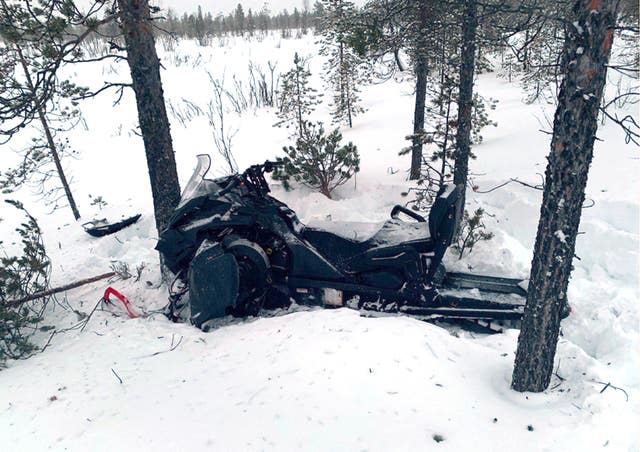Andrew Cannestra suffered a brain injury when his snowmobile crashed near Ivalo, northern Finland, on February 2 2020.
An American neurosurgeon has lost a High Court legal action against a branch of McLaren over a snowmobile crash which he claimed “put my life in danger”.
Andrew Cannestra suffered a brain injury when his snowmobile crashed near Ivalo, northern Finland, on February 2 2020 during a four-night “Pure McLaren Arctic Experience” arranged by McLaren Automotive Events.
Barristers for the 54-year-old Floridian told a trial in London earlier this month that the company was negligent and in breach of contract, including allegations that a safety briefing given by guides for a “snowmobile safari” was inadequate.
They also claimed that a guide sped off, causing Mr Cannestra to lose sight of him and speed up in an attempt to keep up, which led to him losing control of the snowmobile on a turn, veering off the track into deep snow, and hitting a tree.
The company defended the legal action, with its lawyers saying there was “no evidence” the briefing did not meet safety standards and that the “irreducible risk” of the activity was “reasonably controlled”.
In a ruling on Friday, Mr Justice Ritchie said the safety briefing complied with relevant standards and that the crash was caused by Mr Cannestra’s “accidental throttle use” when entering the turn.
He said: “It was not caused by ‘out of sight’ guiding. It was not caused by the claimant going too fast because he was trying to keep up with a disappeared guide.
“It was caused by accidental throttle use by the claimant due to failing to follow the instructions which he had been given about safe operation during a left turn, with the guide well in sight before both turns one and two.”
Neil Block KC, representing Mr Cannestra, told a seven-day free trial in London in written submissions that Mr Cannestra and his former partner, Kaitlin Mealor, spent almost £24,000 before flights on the “couples package”, with activities including driving a McLaren car on ice, and optional events such as snowmobiling.
While Mr Cannestra had experience driving supercars, he and Ms Mealor were “absolute novices” on snowmobiles, Mr Block said.
The barrister said the pair were given a safety briefing by two guides, Arto Pitkanen and Jouni Satta, which lasted “approximately five minutes”, but alleged it was not “proper and adequate” as it did not include information on track layout or the positions of potential hazards.

Mr Block said the Lynx Xtrim 900 snowmobiles had three modes – eco, standard and sport – with the tour beginning in eco mode, which had a top speed of 40kph.
Shortly after the activity began, Mr Block said the group stopped, and Mr Pitkanen approached Mr Cannestra and changed the mode, which increased its top speed and was “not appropriate”.
Mr Pitkanen was alleged to have then set off at speeds of up to 60kph, causing Mr Cannestra to lose sight of him and speed up as he “did not want to be on his own”.
He suffered a “very significant” brain injury and “orthopaedic injuries” as a result of the crash, the court was told.
Giving evidence, Mr Cannestra acknowledged he initially told others following the crash that it was his “error”, but said he was “not thinking clearly” at that time due to his “traumatic brain injury”.
He said: “The guides simply did not guide me through the turns.
“That put my life in danger, and this never would have happened to me if that had occurred.”
Matthew Chapman KC, for the company, said in his written submissions that the turn where Mr Cannestra crashed was “quite safe if negotiated at an appropriate speed”, and that Mr Pitkanen changed the snowmobile’s mode as Mr Cannestra was “eager” for this to happen.
He added that Mr Cannestra’s speed was “wholly within his control”, and the claim that Mr Pitkanen had driven too far in front “cannot sensibly succeed”.
In his judgment, Mr Justice Ritchie ruled that Mr Pitkanen “did not ride at excessive speed” and that the change of the snowmobile’s mode did not have “any proven causative effect on the accident”, adding that Mr Cannestra was “a mature, supercar and jet-ski aficionado, who had ridden confidently and wanted more speed”.
He continued that Mr Cannestra’s evidence was “illogical and contrived” and that a “fundamental problem” with it was that it was “contradictory to what he said after the accident”.
He said: “For a man with substantial experience of driving super cars, with very high intelligence and a clear understanding of the dangers of driving at speed on corners, he based his case on ignoring those dangers and desperately wanting to keep up with a guide.”

